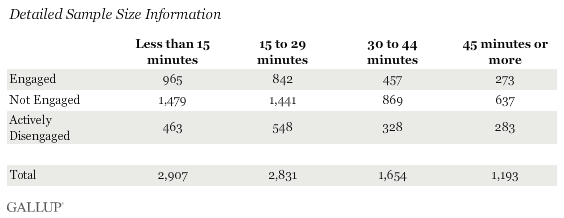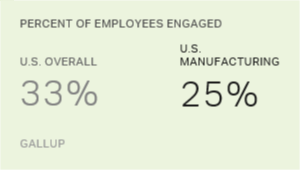WASHINGTON, D.C. -- A long commute may make matters worse for American workers who are "actively disengaged" at work, but is not associated with more daily stress and worry for "engaged" workers. The percentage of actively disengaged workers who report a lot of stress and worry in their lives without a lot of happiness and enjoyment increases from 15.5% for those with short commutes to 27.1% for those with long commutes. In contrast, engaged workers' low worry and stress levels do not change significantly regardless of commute time.

Workers who are "not engaged" -- falling between the engaged and actively disengaged workers -- also experience poorer mood as commute time increases, with a particularly large jump at 45 minutes or more.
Fourteen percent of all American workers report they spend at least 45 minutes getting to work. Gallup has found that commutes of this length are linked to poorer overall well-being, daily mood, and health. Furthermore, disengaged workers do have longer commute times on average compared with engaged workers.
These findings are based on data from the Gallup-Healthways Well-Being Index and include data from a special Gallup Daily tracking series conducted throughout 2011 to explore American workers' engagement levels.
Gallup's employee engagement index is based on worker responses to 12 actionable workplace elements with proven linkages to performance outcomes, including productivity, customer service, quality, retention, safety, and profit. Gallup also finds significant linkages between engagement at work and health and well-being outcomes.
In the fourth quarter of 2011, fewer than one in three American workers was engaged (29%), 52% were not engaged, and 19% were actively disengaged, unchanged from earlier in the year.
Engaged employees are involved in and enthusiastic about their work. Those who are not engaged may be satisfied but are not emotionally connected to their workplaces and less likely to put in discretionary effort. The actively disengaged are emotionally disconnected from their work and workplace, and these workers jeopardize the performance of their teams.
Implications
The Gallup-Healthways Well-Being Index data confirm that for many Americans lengthy treks to work do hamper their mood. However, workers who are engaged in their work and workplace appear to be buffered from some of the effects of long commutes.
Thus, while studies, including ones by Gallup, find that long commutes are associated with poorer well-being, such issues are a bigger problem for employees who are not engaged or are actively disengaged. So, ensuring that employees are engaged in their jobs could help those with long commutes avoid poor-mood days.
Gallup research has long-shown that how employees are managed can significantly influence employee engagement and disengagement, which, in turn, influences the organization's bottom line. Engaged employees are more likely to report happiness and interest in their daily lives, and disengaged employees are more likely to report stress and worry. Recent research suggests these differing moods are associated with the stress hormone cortisol, suggesting possible physiological consequences of the disengagement-commute combination. A recent Swedish study confirms the connection between longer commutes, health complaints, and days missed from work.
Some of the associations between long commutes and health -- such as back pain and obesity -- can be attributed to the sedentary nature of commuting, while other associations -- hypertension, for example -- are likely related to the stress associated with extended stop-and-go traffic and a lack of control over traffic conditions. One study indicated that long commutes cause workers stress during the commute, and then the stress eventually transfers over into their workday.
Engagement at work may buffer the effects of stress from a long commute because engaged workers are more likely to look forward to their work, probably making a long commute more tolerable. And after a good day of work, the drive home is probably more tolerable as well, thereby reducing the chance of high stress during a long commute. Conversely, disengaged workers tend to think of work as a burden, which is likely to influence their mood during their commute both to and from their workplace.
It is important to note that the findings presented in the article do not conclusively determine a causal relationship between engagement, commute time, and mood. For example, since employees with longer commutes are also more likely to be disengaged, both the long commute time and the disengagement are likely contributing to daily stress and worry. Regardless, the findings do suggest that those who do have long daily commutes are likely to fare better off emotionally if they are traveling to and from an engaging workplace.
About Gallup's Employee Engagement Index
Gallup's Employee Engagement Index is based on decades of research studying which workplace elements matter most in driving performance outcomes across organizations throughout the world. Gallup researchers identified 12 elements which are summarized into 12 survey items. A composite of employee responses to the 12 items is used to formulate the Engagement Index groupings (Engaged, Not Engaged, Actively Disengaged).
About the Gallup-Healthways Well-Being Index
The Gallup-Healthways Well-Being Index tracks well-being in the U.S., U.K., and Germany and provides best-in-class solutions for a healthier world. To learn more, please visit well-beingindex.com.
Survey Methods
Results are based on telephone interviews conducted as part of the Gallup Daily tracking survey Jan. 2-Dec. 31, 2011with a random sample of 8,585 adults, aged 18 and older, living in all 50 U.S. states and the District of Columbia, selected using random-digit-dial sampling.
Maximum expected error ranges for subgroups vary according to size, ranging from ±2.3% for the total sample to ±6.3% for the smallest sub-group. Below is a listing of sample sizes for each subgroup in Table 2.

Interviews are conducted with respondents on landline telephones and cellular phones, with interviews conducted in Spanish for respondents who are primarily Spanish-speaking. Each daily sample includes a minimum quota of 400 cell phone respondents and 600 landline respondents, with additional minimum quotas among landline respondents for gender within region. Landline respondents are chosen at random within each household on the basis of which member had the most recent birthday.
Samples are weighted by gender, age, race, Hispanic ethnicity, education, region, adults in the household, cell phone-only status, cell phone-mostly status, and phone lines. Demographic weighting targets are based on the March 2011 Current Population Survey figures for the aged 18 and older non-institutionalized population living in U.S. telephone households. All reported margins of sampling error include the computed design effects for weighting and sample design.
In addition to sampling error, question wording and practical difficulties in conducting surveys can introduce error or bias into the findings of public opinion polls.
For more details on Gallup's polling methodology, visit https://www.gallup.com/.
